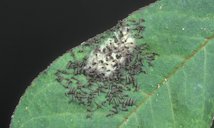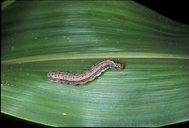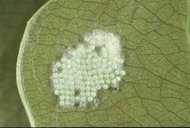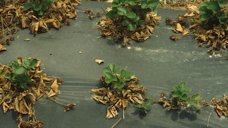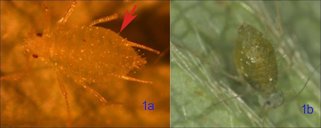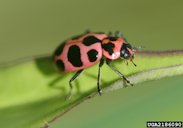| Strawberry Pests | ||||||||||||||||||||||||
|---|---|---|---|---|---|---|---|---|---|---|---|---|---|---|---|---|---|---|---|---|---|---|---|---|
| Back
to Strawberry Page 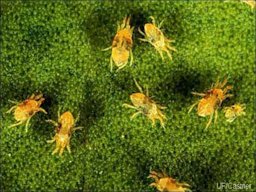 Fig. 1  Twospotted spider mites, Tetranychus urticae  Fig. 2  Webbing produced by twospotted spider mites, T. urticae 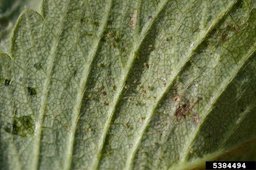 Fig. 3  Strawberry spider mite (T. turkestani) infestation 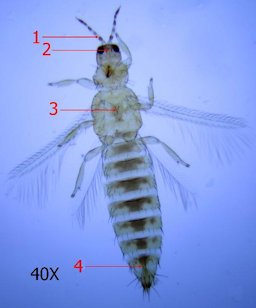 Fig. 4  Western flower thrips adult female. (Frankliniella occidentalis) Arrow 1 indicates location of antennal characteristics; Arrow 2 indicates location of interocular setae; Arrow 3 indicates location of metanotal campaniform sensillae; Arrow 4 indicates location of microtrichial comb on tergite VIII 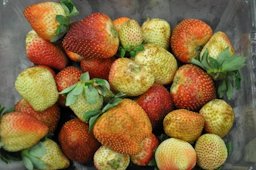 Fig. 5  Thrips damage to strawberry 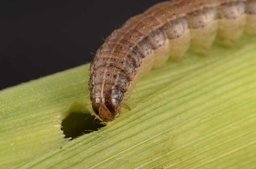 Fig. 8  Head capsule of fall armyworm, Spodoptera frugiperda showing light-colored inverted "Y" on front of head 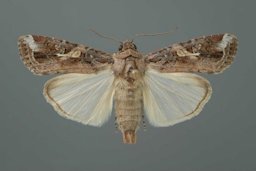 Fig. 9  Typical adult male fall armyworm, Spodoptera frugiperda  Fig. 10  Typical adult female fall armyworm, S. frugiperda 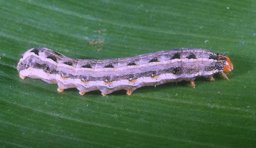 Fig. 13  Mature larva (light form) of the southern armyworm, Spodoptera eridania 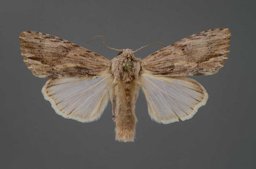 Fig. 14  Adult of the southern armyworm, S. eridania 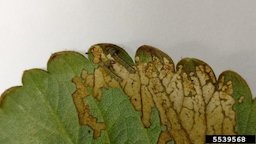 Fig. 15  Southern armyworm (S. eridania) damage on strawberry 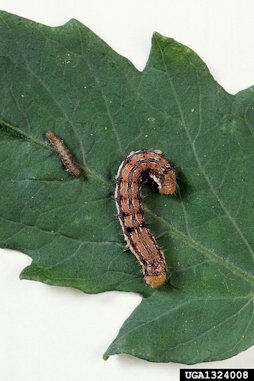 Fig. 16  Corn earworm (Helicoverpa zea) a normal corn earworm larva (right) dwarfs one fed on a genetically altered baculovirus, both larvae are 10 days old 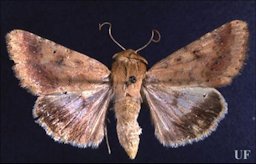 Fig. 17  Corn earworm (H. zea)  Fig. 18  Strawberry fruits infested with a sap beetle adult  Fig. 19  Adults of the three most common sap beetle species in Florida strawberry. (A) Carpophilus fumatus (B) Lobiopa insularis (0.25 in) (C) Epuraea luteola (0.1 in)  Fig. 20  Strawberry roots damaged by Belonolaimus longicaudatus  Fig. 21  A strawberry field infested by B. longicaudatus has patches of stunted plants 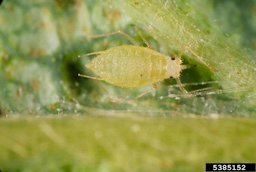 Fig. 25  Strawberry aphid (Chaetosiphon fragaefolii)
|
The
principal pests on strawberry in Florida are the twospotted spider
mite, thrips, and lepidopterous larvae (fall and southern armyworms).
Minor and occasional pests include corn earworm and sap beetles.
Insects that may occasionally be seen on strawberry, but are generally
managed incidentally, include fruit flies, whiteflies, lygus bugs,
saltmarsh caterpillars, aphids, leafrollers, tobacco budworms, mole
crickets, and ants. 1 Spider Mites Tetranychus urticae, T. turkestani, T. tumidus The twospotted spider mite (T. urticae) is oval, about 0.5 mm long, and may be brown or orange-red, but a green, greenish-yellow or an almost translucent color is most common. All mites have needle-like, piercing-sucking mouthparts. Spider mites feed by penetrating the plant tissue with their mouthparts and are typically found on the underside of the leaf. Spider mites spin fine strands of webbing on the host plant—hence their name. When twospotted spider mites remove the sap, the mesophyll tissue collapses, and a small chlorotic spot forms at each feeding site. Continued feeding causes a stippled-bleached effect on the upper surfaces of leaves, and later the leaves turn yellow, gray, or bronze. Complete defoliation may occur if the mites are not controlled. 1 Control methods 2 Predators are very important in regulating spider mite populations and should be protected whenever possible. Important genera include the predatory mites, Amblyseius, Metaseiulus, and Phytoseiulus; the lady beetles, Stethorus; the minute pirate bugs, Orius; the thrips, Leptothrips; and the lacewing larvae, Chrysopa. In greenhouses, the ghost ant, Tapinoma melanocephalum (Fabricius), a pest in itself, was also reported as a significant predator (Osborne et al. 1995). Insecticidal soaps and oils should be carefully considered when a pesticide is required. They are effective against mites and the least toxic to people, other non-target organisms and the environment. The twospotted spider mite develops a resistance to most acaricides after prolonged use. Most miticides are not effective on eggs. Therefore, two or more applications of the miticide will be required at five-day intervals during the summer or seven-day intervals during the winter. Further Reading Twospotted Spider Mite, Tetranychus urticae Koch, University of Florida pdf Thrips Frankliniella occidentalis/Scirtothrips dorsalis The western flower thrips and the newly emergent chili thrips have become an increasingly larger concern for strawberry growers in Florida. These insects feed in the flowers and lead to poor fruit set and berry malformation. They can be easily confused with non-harmful thrips species, so precise scouting is required to determine which species are present and whether they are at a density requiring treatment 1 Control methods 3 Cultural controls include using UV-reflective mulch and reducing the amount of nitrogen applied to the crop (Stavisky et al. 2002). UV-reflective mulch has been successfully used in tomato for reduction of thrips that vector plant disease (Funderburk et al. 2013). Biological control includes the use of predatory mites and insects to reduce the population of pest thrips. Agents such as minute pirate bugs (Orius insidiosus) and predatory mites (Amblyseius swirskii) can be useful for controlling thrips populations and are commercially available (Arthurs et al. 2009). Naturally occurring thrips predators in Florida strawberry fields include minute pirate bugs, ladybird beetles, lacewings, and predatory mites. Insecticide application decisions for thrips management in strawberry should take into account the presence of naturally occurring natural enemies and the species of thrips present. Chemical control is another option available for the management of thrips populations. When using chemical control, it is necessary to rotate insecticide groups to prevent a buildup of resistance in thrips populations. Further Reading Thrips in Florida Strawberry Crops, University of Florida pdf Fall Armyworm Spodoptera frugiperda The fall armyworm is native to the tropical regions of the western hemisphere from the United States to Argentina. It normally overwinters successfully in the United States only in southern Florida and southern Texas. The fall armyworm is a strong flier, and disperses long distances annually during the summer months. 4 Larvae cause damage by consuming foliage. Older larvae cause extensive defoliation. Among vegetable crops, only sweet corn is regularly damaged, but others are attacked occasionally. Other crops sometimes injured are apple, grape, orange, papaya, peach, strawberry and a number of flowers. 4 Control methods The predators of fall armyworm are general predators that attack many other caterpillars. Among the predators noted as important are various ground beetles (Coleoptera: Carabidae); the striped earwig, Labidura riparia (Pallas) (Dermaptera: Labiduridae); the spined soldier bug, Podisus maculiventris (Say) (Hemiptera: Pentatomidae); and the insidious flower bug, Orius insidiosus (Say) (Hemiptera: Anthocoridae). 4 For more information on Insect Management consult your County Extension Agent.
Fig. 6. Eggs of the fall armyworm, Spodoptera frugiperda, hatching Fig. 7. Mature larva of the fall armyworm Further Reading Fall Armyworm, Spodoptera frugiperda (J.E. Smith), University of Florida pdf Southern Armyworm Spodoptera eridania The forewings of the mature armyworm moth are gray and brown with irregular dark brown and black markings. Up to four generations per year occur in Florida. Larvae are defoliators and feed gregariously while young, often skeletonizing leaves. As they mature, they become solitary and may feed on the surface of fruit. 1 Control methods Several wasp parasitoids commonly associated with caterpillars of other species, including Cotesia marginiventris (Cresson), Chelonus insularis Cresson, Meteorus autographae Muesebeck, and M. laphygmae Viereck (all Hymenoptera: Braconidae) also attack southern armyworm. Meteorus autographae was the dominant parasitoid in a Florida study (Tingle et al. 1978). Also reared from southern armyworm are Campoletis flavicincta (Ashmead) and Ophion flavidus Brulle (both Hymenoptera: Ichneumonidae); Euplectrus platyhypenae Howard (Hymenoptera: Eulophidae); Choeteprosopa hedemanni Braeur and Bergenstamm, Euphorocera claripennis (Macquart), Gonia crassicornis (Fabricius), Winthemia quadripustulata (Fabricius), and W. rufopicta (Bigot) (all Diptera: Tachinidae). 5 Southern armyworm is best controlled with foliar insecticides when larvae are small. Insecticides vary considerably in their toxicity to larvae, and larvae are difficult to control with botanical insecticides. For specific chemical recommendations consult your County Extension Agent. 5
Fig. 11. Eggs of southern armyworm, Spodoptera eridania Fig. 12. Southern armyworm, second and third instar larvae on tomato Further Reading Southern Armyworm, Spodoptera eridania (Stoll), University of Florida pdf Corn Earworm Helicoverpa zea This caterpillar, also called tomato fruitworm and cotton bollworm, attacks a wide variety of vegetable and field crops. It is capable of overwintering throughout the state. There are up to seven generations per year in Florida, but like fall armyworms, the aggressive and cannibalistic nature of the larvae limit the number of mature larvae present at any one time. Both larva and adult corn earworm are variable in color and pattern. 1 Corn earworm is considered by some to be the most costly crop pest in North America. 6 Control method Although numerous natural enemies have been identified, they usually are not effective at causing high levels of earworm mortality or preventing crop injury. 6 General predators often feed on eggs and larvae of corn earworm; over 100 insect species have been observed to feed on H. zea. Among the common predators are ladybird beetles such as convergent lady beetle, Hippodamia convergens Guerin-Meneville, and Coleomegilla maculata DeGeer (both Coleoptera: Coccinellidae); softwinged flower beetles, Collops spp. (Coleoptera: Melyridae); green lacewings, Chrysopa and Chrysoperla spp. (Neuroptera: Chrysopidae); minute pirate bug, Orius tristicolor (White) (Hemiptera: Anthocoridae); and big-eyed bugs, Geocoris spp. (Hemiptera: Lygaeidae). 6 Further Reading Corn Earworm, Helicoverpa (=Heliothis) zea (Boddie), University of Florida pdf Sap Beetles Coleoptera: Nitidulidae Sometimes called nitidulids or picnic beetles, these beetles overwinter in pupal or adult stages and become active early in spring with subsequent egg deposition at that time. Both larval and adult sap beetles feed on strawberry, although many other vegetable crops are preferred hosts. In Florida, conditions can support two generations of sap beetles per year. 1 Sap beetles work in association with yeasts and other fungi causing the fermentation and decay of infested plant parts. They also transport a variety of microorganisms that cause plant diseases, and a few species behave as predators of various ornamental pests (Dowd and Weber 1991). Sap beetles are often considered minor pests; however, their main impact is due to the contamination of products caused by adults and larvae. 7 Control methods Sap beetles are not usually economically important in field, fresh-market strawberries; however, when overripe strawberries are harvested for processing, sap beetles may infest the fruit and make the product unmarketable. For biological, cultural and chemical control, consult the following publication: Further Reading Sap Beetle (Coleoptera: Nitidulidae) Management in Strawberries, University of Florida pdf Sap Beetles (of Florida), Nitidulidae, University of Florida pdf Nematodes Nematodes are a serious problem affecting Florida strawberry production areas as well as the primary driving pest. No nematode-resistant strawberry varieties exist, and there are no postplant remediation strategies available. Strawberries are susceptible to multiple nematode species. Sting nematodes, root-knot nematodes, and foliar nematodes are the main problems, with sting nematode being by far the most severe.1
Fig. 23. Strawberry plant stunting caused by the sting nematode (B. longicaudatus). Note irregular or patchy field distribution of stunted plants rather than throughout the entire field. Fig. 24. Progressive decline of strawberry due to sting nematode. Note death of leaves from outside in towards the crown (oldest to youngest leaves). Fig. 24. Sting nematode, induced symptoms on strawberry roots. Note short, dark and discolored abbreviated roots with swollen root tips. Further Reading Foliar or Bud Nematodes in Florida Strawberries, University of Florida pdf Sting Nematode Belonolaimus longicaudatus Rau, University of Florida pdf Strawberry Aphids Chaetosiphon fragaefolli The strawberry (Fragaria x ananassa Duchesne) hosts a wide variety of aphid species. Most of these species have an ample variety of alternate hosts that include strawberries. The true strawberry aphid, C. fragaefolli (Cockerell) (Fig. 25), is considered an important pest of wild and cultivated strawberries worldwide. This aphid species is a vector of strawberry viruses such as cytorhabdovirus, also known as strawberry crinkle virus (SCV), one of the most dangerous viruses affecting strawberry (Krczal, 1979). 8 Control methods Effective and timely control of the strawberry aphid is essential in strawberry production due to rapid population growth. 8 Chemical control should be considered as a first measure if viruses transmitted by this aphid are detected. For different chemical options, visit the following sites, http://edis.ifas. ufl.edu/PI037 or http://edis.ifas.ufl.edu/cv134. 8 It takes only one aphid to spread the virus in your crop; however, keep in mind that not all strawberry aphids transmit viruses. There is no extended information regarding the effect of natural enemies specifically on the strawberry aphid in Florida. In the UK, the lacewing larvae, Chrysoperla carnea, consumed several strawberry aphids during their development. Additionally, open field experiments Parasitoids are very specific to the species of aphid they attack. So far, there are no reports in the literature for strawberry aphid control by parasitoid wasps. There are several biological control options for aphid control. Lady beetles, such as Hippodamia convergens Güerin-Menevielle (Fig. 27) and Coleomegilla maculata (DeGeer) (Fig. 28), are excellent aphid feeders (Rondon et al., 2004). Lacewings such as Chrysoperla spp. (Fig. 29), and the predatory midge Aphidoletes aphidimyza L. are also voracious predators of aphids (Fig. 30) (Heinz, 1998). 8
Fig. 26. The aphid is typically pale green to yellowish in color. Both adults and nymphs are covered with knobbed hairs that are visible with a hand lens (20X); these hairs are not found on any of the other aphid species infesting strawberry Fig. 27. Hippodamia spp. adult Fig. 28. Spotted lady beetle (Coleomegilla maculata) Fig. 29. Green lacewing (Chrysoperla rufilabris) adult Further Reading Biology and Control of the Strawberry Aphid, Chaetosiphon fragaefolli (Cockerell) in Florida, University of Florida pdf Further Reading Beneficial Strawberry Insects, University of California IPM pdf Pesticide Options for Insect, Mite, and Mollusk Management in Commercial Strawberry Production in Florida, University of Florida pdf Arthropod Pest Management Practices of Strawberry Growers in Florida, University of Florida pdf |
|||||||||||||||||||||||
| Bibliography 1 Mossler, Mark A. "Florida Crop/Pest Management Profiles: Strawberry." Agronomy Dept., UF/IFAS Extension, CIR1239, Original pub. Dec. 2000, Revised Apr. 2003, Jan. 2004, July 2010, and Sept. 2012, Reviewed Dec. 2015, AskIFAS, Archived, edis.ifas.ufl.edu/pi037. Accessed 13 Nov. 2017. 2 Fasulo, Thomas R., and H. A. Denmark. "Twospotted Spider Mite, Tetranychus urticae Koch (Arachnida: Acari: Tetranychidae)." Entomology and Nematology Dept., UF/IFAS Extension, EENY150 (originally published as DPI Entomology Cir. 89), Original pub. Aug. 2000, Revised Dec. 2009, Reviewed Jan.2016, and Jan. 2022, AskIFAS, edis.ifas.ufl.edu/in307. Accessed 13 Nov. 2017, 7 Jan. 2024. 3 Cluever, Jeff D., et al. "Thrips in Florida Strawberry Crops." Entomology and Nematology Department, UF/IFAS Extension, ENY-882, Original pub. Jan. 2015, Reviewed June 2018, and 3 Jan. 2022, AskIFAS, edis.ifas.ufl.edu/in1078. Accessed 13 Nov. 2017, 18 Sept. 2019, 7 Jan. 2024. 4 Capinera, John L. "Fall Armyworm, Spodoptera frugiperda (J.E. Smith) (Insecta: Lepidoptera: Noctuidae)." Entomology and Nematology Dept., UF/IFAS Extension, EENY098, Original pub. July 1999, Revised Nov. 2005, May 2017, Reviewed June 2020, AskIFAS, edis.ifas.ufl.edu/in255. Accessed 13 Nov. 2017, 6 Jan. 2024. 5 Capinera, John L. "Southern Armyworm, Spodoptera eridania (Stoll) (Insecta: Lepidoptera: Noctuidae)." Entomology and Nematology Dept., UF/IFAS Extension, UF/IFAS Extension, Original pub. Aug. 1999, Revised Nov.2005, May 2017, Oct. 2018 and July 2022, EENY-106, AskIFAS, edis.ifas.ufl.edu/in263. Accessed 16 Nov. 2017, 18 Sept. 2019, 7 Jan. 2024. 6 Capinera, John L. "Corn Earworm, Helicoverpa (=Heliothis) zea (Boddie) (Lepidoptera: Noctuidae)." Entomology and Nematology Dept., UF/IFAS Extension, EENY-145 (IN302), Original pub. July 2000, Revised June 2017, Reviewed June 2020, AskIFAS, edis.ifas.ufl.edu/in302. Accessed 16 Nov. 2017, 6 Jan. 2024. 7 Rondon, Silvia I., et al. "Sap Beetle (Coleoptera: Nitidulidae) Management in Strawberries." Horticultural Sciences Dept., UF/IFAS Extension, HS993, Original pub. Oct. 2004, Revised July 2017, Reviewed 5 January 2022, AskIFAS, edis.ifas.ufl.edu/hs234. Accessed 22 Nov. 2017, 6 Jan. 2024. 8 Rondon, Silvia I., and Daniel J. Cantliffe. "Biology and Control of the Strawberry Aphid, Chaetosiphon fragaefolli (Cockerell) (Homoptera: Aphididae) in Florida." Horticultural Sciences Dept., UF/IFAS Extension, HS1009, Original pub. Mar. 2005, Reviewed Dec. 2017, Reviewed 6 Jan. 2022, AskIFAS, edis.ifas.ufl.edu/hs253. Accessed 27 Nov. 2017, 18 Sept. 2019, 6 Jan. 2024. Photographs Fig. 1 Castner, J. "Twospotted Spider Mite, Tetranychus urticae Koch." Entomology and Nematology Dept., UF/IFAS Extension, AskIFAS, edis.ifas.ufl.edu/in307. Accessed 13 Nov. 2017. Fig. 2 "Webbing produced by twospotted spider mites, Tetranychus urticae Koch." Entomology and Nematology Dept., UF/IFAS Extension, AskIFAS, edis.ifas.ufl.edu/in307. Accessed 13 Nov. 2017. Fig. 3 Hummel, Natalie. "Strawberry spider mite (Tetranychus turkestani) infestation." Louisiana State University AgCenter, Uploaded Nov. 3, 2008, Updated Jan. 9, 2009, Bugwood.org, (CC BY-NC 3.0 US), www.insectimages.org/browse/detail.cfm?imgnum=5384494. Accessed 13 Nov. 2017. Fig. 4 Cluever, JD. "Western flower thrips adult female." Entomology and Nematology Dept., UF/IFAS Extension, AskIFAS, edis.ifas.ufl.edu/in1078. Accessed 13 Nov. 2017. Fig. 5 Smith, H.A. "Thrips damage to Strawberry." Entomology and Nematology Dept., UF/IFAS Extension, AskIFAS, edis.ifas.ufl.edu/in1078. Accessed 13 Nov. 2017. Fig. 6 Castner, James. "Eggs of the fall armyworm, Spodoptera frugiperda (J.E. Smith), hatching." Entomology and Nematology Dept., UF/IFAS Extension, AskIFAS, edis.ifas.ufl.edu/in255. Accessed 16 Nov. 2017. Fig. 7 Castner, James. "Mature larva of the fall armyworm, Spodoptera frugiperda (J.E. Smith)." Entomology and Nematology Dept., UF/IFAS Extension, AskIFAS, edis.ifas.ufl.edu/in255. Accessed 16 Nov. 2017. Fig. 8 Buss, Lyle. "Head capsule of fall armyworm, Spodoptera frugiperda (J.E. Smith) showing light-colored inverted "Y" on front of head." Entomology and Nematology Dept., UF/IFAS Extension, AskIFAS, edis.ifas.ufl.edu/in255. Accessed 16 Nov. 2017. Fig. 9 Buss, Lyle. "Typical adult male fall armyworm, Spodoptera frugiperda (J.E. Smith)." Entomology and Nematology Dept., UF/IFAS Extension, AskIFAS, edis.ifas.ufl.edu/in255. Accessed 16 Nov. 2017. Fig. 10 Buss, Lyle. "Typical adult female fall armyworm, Spodoptera frugiperda (J.E. Smith)." Entomology and Nematology Dept., UF/IFAS Extension, AskIFAS, edis.ifas.ufl.edu/in255. Accessed 16 Nov. 2017. Fig. 11 Buss, Lyle. "Eggs of southern armyworm, Spodoptera eridania (Stoll)." Entomology and Nematology Dept., UF/IFAS Extension, AskIFAS, edis.ifas.ufl.edu/in263. Accessed 16 Nov. 2017. Fig. 12 Buss, Lyle. "Southern armyworm, Spodoptera eridania (Stoll), second and third instar larvae on tomato." Entomology and Nematology Dept., UF/IFAS Extension, AskIFAS, edis.ifas.ufl.edu/in263. Accessed 16 Nov. 2017. Fig. 13 Capinera, John L. "Mature larva (light form) of the southern armyworm, Spodoptera eridania (Stoll)." Entomology and Nematology Dept., UF/IFAS Extension, AskIFAS, edis.ifas.ufl.edu/in263. Accessed 16 Nov. 2017. Fig. 14 Buss, Lyle. "Adult of the southern armyworm, Spodoptera eridania (Stoll)." Entomology and Nematology Dept., UF/IFAS Extension, AskIFAS, edis.ifas.ufl.edu/in263. Accessed 16 Nov. 2017. Fig. 15 Hamann, Jonas Janner. "Southern armyworm (Spodoptera eridania ) on strawberry." Universidade Federal de Santa Maria (UFSM), Uploaded Nov. 2, 2015, Updated Dec. 13, 2015, Bugwood.org, (CC BY 3.0 US), www.forestryimages.org/browse/detail.cfm?imgnum=5539568. Accessed 16 Nov. 2017. Fig. 16 Bauer, Scott. "Corn earworm (Helicoverpa zea) a normal corn earworm larva (right) dwarfs one fed on a genetically altered baculovirus. Both larvae are 10 days old." USDA Agricultural Research Service, Uploaded Mar. 5, 2003, Updated Mar. 12, 2003, Bugwood.org, (CC BY 3.0 US), www.forestryimages.org/browse/detail.cfm?imgnum=1324008. Accessed 16 Nov. 2017. Fig. 17 Capinera, John L. "Adult corn earworm (Helicoverpa zea) (Boddie)." Featured Creatures, Entomology and Nematology Dept. UF/IFAS Extension, AskIFAS, edis.ifas.ufl.edu/Lin302. Accessed 16 Nov. 2017. Fig. 18 Price, J. F. "Strawberry fruits infested with a sap beetle adult." Horticultural Sciences Dept., UF/IFAS Extension, AskIFAS, edis.ifas.ufl.edu/hs234. Accessed 22 Nov. 2017. Fig. 19 Buss, Lyle. "Adults of the three most common sap beetle species in Florida strawberry. (A) Carpophilus fumatus (B) Lobiopa insularis (0.25 in) (C) Epuraea luteola (0.1 in). Note exposed abdominal segments in (A) and (C) and distinctly clubbed antennae in (C)." Horticultural Sciences Dept., UF/IFAS Extension, AskIFAS, edis.ifas.ufl.edu/hs234. Accessed 22 Nov. 2017. Fig. 20 Hamill, J. "Strawberry roots damaged by Belonolaimus longicaudatus." Entomology and Nematology Dept., UF/IFAS Extension, AskIFAS, edis.ifas.ufl.edu/in395. Accessed 22 Nov. 2017. Fig. 21 Hamill, J. "A strawberry field infested by Belonolaimus longicaudatus has patches of stunted plants." Entomology and Nematology Dept., UF/IFAS Extension, AskIFAS, edis.ifas.ufl.edu/in395. Accessed 22 Nov. 2017. Fig. 22 "Strawberry plant stunting caused by the sting nematode (Belonolaimus longicaudatus). Note irregular or patchy field distribution of stunted plants rather than throughout the entire field." Entomology and Nematology Dept., UF/IFAS Extension, AskIFAS, dis.ifas.ufl.edu/in395. Accessed 22 Nov. 2017. Fig. 23 "Progressive decline of strawberry due to sting nematode, Belonolaimus longicaudatus. Note death of leaves from outside in towards the crown (oldest to youngest leaves)." Entomology and Nematology Dept., UF/IFAS Extension, AskIFAS, edis.ifas.ufl.edu/in395. Accessed 22 Nov. 2017. Fig. 24 "Sting nematode, Belonolaimus longicaudatus, induced symptoms on strawberry roots. Note short, dark and discolored abbreviated roots with swollen root tips." Entomology and Nematology Dept., UF/IFAS Extension, AskIFAS, edis.ifas.ufl.edu/in395. Accessed 22 Nov. 2017. Fig. 25 Lotz, Jeffrey W. "Strawberry aphid adult, Chaetosiphon fragaefolli." Florida Dept. of Agriculture and Consumer Services, Uploaded Nov 3, 2008, Updated Sept. 28, 2010, Bugwood.org, (CC BY 3.0 US), www.forestryimages.org/browse/detail.cfm?imgnum=5385152. Accessed 27 Nov. 2017. Fig. 26 Cantliffe, D. J., and S.I. Rondon. "The aphid is typically pale green to yellowish in color. Both adults and nymphs are covered with knobbed hairs that are visible with a hand lens (20X); these hairs are not found on any of the other aphid species infesting strawberry." Horticultural Sciences Dept., UF/IFAS Extension, AskIFAS, edis.ifas.ufl.edu/hs253. Accessed 27 Nov. 2017. Fig. 27 Michaud, J. P. "Hippodamia spp. adult." Horticultural Sciences Dept., UF/IFAS Extension, AskIFAS, edis.ifas.ufl.edu/hs253. Accessed 27 Nov. 2017. Fig. 28 Cappaert, David. "Spotted lady beetle (Coleomegilla maculata)." Bugwood.org, Uploaded Aug.17, 2006, Updated Jan. 24, 2011, (CC BY 3.0 US), www.forestryimages.org/browse/detail.cfm?imgnum=2186090. Accessed 27 Nov. 2017. Fig. 29 Berger, Joseph. "Green lacewing (Chrysoperla rufilabris) adult." Bugwood.org, Uploaded July 20, 2005, Updated July 29, 2011, (CC BY 3.0 US), www.forestryimages.org/browse/detail.cfm?imgnum=1386017. Accessed 27 Nov. 2017. Published 22 Nov. 2017 LR. Last update 7 Jan. 2024 LR |
||||||||||||||||||||||||
